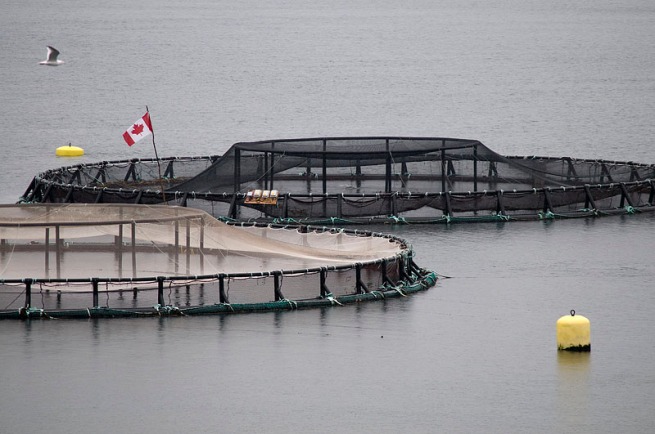In response to the depletion of wild fish, the Government of Canada has acted to implement fish farms as an alternative means to traditional fishing. If the goal of the government is to entice entrepreneurs in wealth-creating aquaculture then every single program is failing miserably. However, if the goal is to perpetuate bureaucracies, supply Americans with cheap fish and promote state-capitalism through nationalized resources and exclusive contracts with foreign multinationals – then mission accomplished.
The lack of private property rights in water practically guarantees that wild fisheries will suffer from a tragedy of the commons. Refusing to acknowledge this cause, the Government of Canada has taken action to solve the tragedy they've created by process of creating yet another problem. Despite the optimism that welcomed state aquaculture policy, the industry's birth was engulfed by a bureaucratic regulatory regime indirectly controlled by wild fishery lobbyists. These lobbyists, who also represent the sport-fishing tourist industry, work with the various state bureaus to limit aquaculture's market share. One of their programs was called the Shellfish Development Initiative (SDI).
In British Columbia, the SDI worked its way through the regulatory regime as a way of “creating thousands of new jobs” in the aquaculture sector, “particularly in coastal communities hard hit by declines in other resource sectors.” Indeed, the idea of aquaculture must have permeated throughout the halls of lobbyists and state bureaus connected to the wild fishery and tourist industries. Former Liberal federal fisheries minister Herb Dhaliwal predicted an industry worth $2 billion. The federal Western Economic Diversification program predicated British Columbia shellfish production to hit $100 million by 2006. In reality, the industry was producing $18.7 million in 2005, $1.3 million less than the previous year.
The SDI program suffered from a host of problems. Poor intergovernmental coordination, premature expansion announcements, little to no consultation with the local communities, uncertainty around First Nations property claims and lack of appropriate processing facilities and distribution networks. All this could have been predicted if one took notice to the regulatory regime inheriting the industry; bureaucrats and lobbyists acting to limit the supply of shellfish production. The end result is an industry where development has become “an end to itself.”
The problem isn't aquaculture but the way in which governments have developed the industry since its current incarnation in 1984. Like its competition – wild fisheries – the problem of management and development lay in the lack of private property rights and reliance on coercion. Before looking further into what's gone wrong with the industry, one must examine how industries develop without state interference.
According to Canadian writer and activist Jane Jacobs, an economy is dependent on city centres, or marketplaces. It is here among the seemingly chaotic interactions of individuals where invention and innovation take place. Technology and knowledge improves, everything becomes more capital intensive and work branches off into new kinds of work. This method of economic development also mirrors the Austrian School, where the subjective valuations of individuals give rise to price and wages that signal to entrepreneurs how best to meet consumer demand. In both descriptions, the economic system is one where voluntary interaction of people result in a higher standard of living.
In Canada, aquaculture developed by having a territorial monopoly take money from people and spend it according to their ideas on how to develop the industry. By resorting to this practice, a host of problems arise that the authorities in turn blame on the free market that never even existed. For example, through government contracts Norwegian multinationals supply the capital for aquaculture development in Canada. An already developed industry, foreign aquaculturists have little need for large scale employment or diversification in the local economy. From 50 companies in 1989 to 12 in 2002, the Canadian Centre for Policy Alternatives notes, “the 1990's [BC] industry tripled its production without any increase in employment.”
These apparent market forces are results of prior government interference and lack of property rights. Norwegian producers can only lease the property the Government of Canada claims to own. This causes incentives for environmental protection to take a back seat to short-term profitability. High Canadian import tariffs and selective trade agreements with the USA give the Norwegian corporations incentives to operate in Canadian borders. But the issue isn't whether ownership is foreign or domestic – it is a question of public or private.
If all sea coasts, inland fisheries, lakes, rivers and ponds in Canada were privately and independently owned by entrepreneurs, both the wild fishery and aquaculture industries would improve drastically. Regarding the latter, Norwegians aquaculturists could still do business in Canada but their long-term profitability would be dependent on their property's environmental sustainability. Private ownership of water is indeed a counter-intuitive idea for most people, yet it precisely this method of ownership that gives rise to industry, commerce and true sustainability. Private property is the only way to fix the Canadian aquaculture mess.
Without state interference in subsidizing transportation and communication infrastructure, exports, regional development and regulations aimed at preventing fluctuations in supply and demand – Canadian aquaculture industry could evolve from its low-value-added bulk production by “branching off into new kinds of work,” or what the Austrians call specialization and the division of labour. Yet the disappearance of the regulatory regime is unlikely to occur in the near future. Bureaucratic disagreements over property ownership pervade the federal and provincial governments. As Ludwig von Mises wrote, “If you have to convince a group of people who are not directly dependent on a solution of a problem, you will never succeed.”
Sources:
Constitution Act 1867
Howlett, Michael and Brownsey Keith. Canada's Resource Economy in Transition: The Past, Present and Future of Canadian Staples Industries. Toronto, Canada: Emond Montgomery Publications Limited, 2008. Print.
Jacobs, Jane. The Economy of Cities. New York: Knopf Doubleday Publishing, 1970. Print
Mises, Ludwig von. Bureaucracy. Indianapolis: Liberty Fund, 2007. Print.
Rothbard, Murray. "Concerning Water" The Freeman: Ideas on Liberty March 1956: 61-64. Print.



The design of this blog is good, I am also thinking to make such blog for my business, thanks, this is really great, keep it up.
ReplyDeleteCommodity Market
In this article you have showed a touch of Canadian Aquaculture. I have desire to get information regarding Aquaculture of different countries including Canada. Now i got this post which have valuable information related to it. Now i'm looking a site which have reviews of http://www.essayswritersland.com/rushessay-com-review/ and if anyone know the name of such reliable source then must let me know about it.
ReplyDelete
ReplyDeleteWas born in rolex replica uk 1955. Rugged, using some special technology replica watches and dedicated features. Have a strong resistance to uk replica watches magnetic.Part II: Disassembly and installation movement.
most of them play the game. steam gift card codes
ReplyDelete